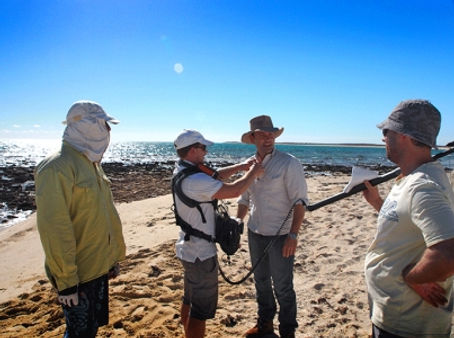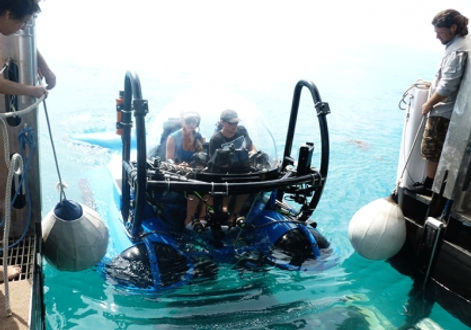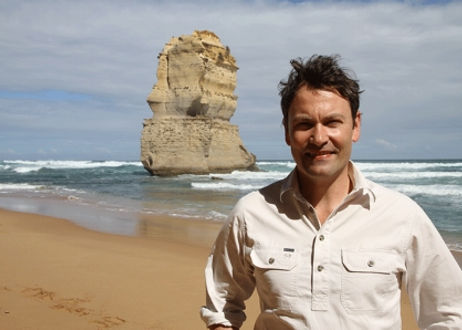RAWGOLD ON TV
TV JOURNEY
7mate – The Weekend Prospector
Andrew is a well known and respected author of several publications and has prospected across the country. From the humble pan to sophisticated electronic equipment, Andrew will share all of his knowledge not only as a geologist but also as a mad keen prospector. Andrew has an abundance of skill and an uncanny knack of finding gold which has lead him to some of the wildest outback country of Australia. His passion for prospecting has been further developed by an Honours Degree in Geology that has enhanced his abilities and success rate as a prospector. The Weekend Prospector series 3 will see Andrew as the new host and he brings a wealth of knowledge to your lounge room every weekend on the what, why and how to find more gold, more often.
Aired on September 2020-2021 
National Geographic – Australia – Life on the Edge
With a passion for gold, Andrew’s first idea for television was a gold prospecting show, an idea he developed in 1997 while studying a Bachelor of Applied Science, Geology at the University of Ballarat (he went on to complete his Honours in Geology in 1999). He pitched the idea which led to a pilot for gold prospecting and metal detecting that Andrew said “didn’t stick at the time”. However through his involvement with the pilot and geology he became known in the television world and was asked to co-host Australia: Life on the Edge because of his geological knowledge, charisma and ability to convey messages to an audience.
National Geographic – Australia – Life on the Edge
The six episode series told the unique stories of life on Australia’s coastline. Andrew, a geologist, shared the role of host with author and adventurer Paul Carter, marine biologist Giovanna Fasanelli and historian Mat McLachlan.
Andrew covered most of the natural and earth science aspects of the series and topics included the Great Ocean Road where he went abseiling at the iconic Twelve Apostles, the Perth Canyon – which is larger than the Grand Canyon, the Gold Coast where he explains the importance of sand to the region and to Australia, Western Australia’s iron ore industry including the largest bulk export handling port in the world – Port Hedland and the formation of Sydney.
Pilbara Coast
Discover how marine organisms that actually look like rocks, gave life to the earth, they started to produce oxygen some 3 billion years ago. This not only lead to life as we know it, but played a significant role in the production of the huge iron ore deposits located in the Pilbara region of Western Australia.
How did the iron ore deposits of the Pilbara in Western Australia form? Andrew takes you on a journey describing their formation, visiting an operating iron ore mine and blasting the stuff out of the ground! Finally he travels to Port Hedland, the largest export bulk handling Port in the World to see how iron ore is loaded onto huge shipping vessels, prior to their departure to locations such as China.

Montgomery Reef
The spectacular north west coast of the Kimberley is one of nature’s wonderland. The spectacular coast holds countless surprises. Extreme tides have created a unique marine environment and one of its treasures, Montgomery Reef. Exposed for only a matter hours between massive tides, this Island Reef provides a window into the beauty and abundance of marine wildlife.
The Aborigines also thrived in this region and we explore elements of a lost culture and the history of 7 foot tall islanders who lived on High Cliffy Island. We try to solve the mystery of ancient circular stone ruins, we find trading and hunting artifacts and we are exposed to a sacred site that opens more spiritual and cultural stories from a time long ago.

Shipwreck Coast
Andrew describes how the spectacular Shipwreck Coast formed and how quickly the Coast is being eroded. The 12 Apostles have been shaped not only by the relentless weathering from wind, rain, ice and the severe hammering by the Southern Ocean, but the Geology and natural features of the coastline itself. Get up close as Andrew abseils down a cliff at Gibson Steps and explains why these limestone cliffs are so susceptible to erosion.
David Darrington has seen first hand how quickly the Coast can change. He was a survivor left standing on a stack when the popular attraction, London Bridge collapsed in 1990. Andrew talks to David and views some amazing photographs taken by David during the minutes that London Bridge collapsed.


